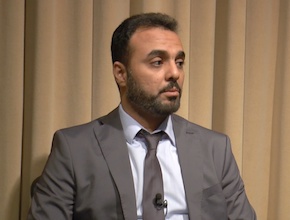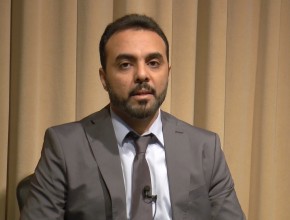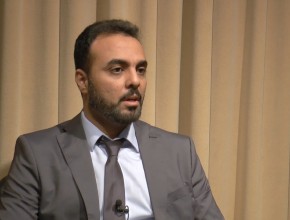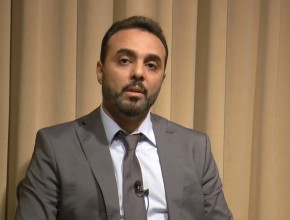References
Rhodes A, Evans LE, Alhazzani W, et al. Surviving Sepsis Campaign: International Guidelines for Management of Sepsis and Septic Shock: 2016. Crit Care Med. 2017 Jan 17. doi: 10.1097/CCM.0000000000002255. [Epub ahead of print] PubMed PMID: 28098591.Guérin C, Reignier J, Richard JC, et al; PROSEVA Study Group. Prone positioning in severe acute respiratory distress syndrome. N Engl J Med. 2013 Jun 6;368(23):2159-68. doi: 10.1056/NEJMoa1214103. Epub 2013 May 20. PubMed PMID: 23688302.
Meade MO, Cook DJ, Guyatt GH, et al; Lung Open Ventilation Study Investigators. Ventilation strategy using low tidal volumes, recruitment maneuvers, and high positive end-expiratory pressure for acute lung injury and acute respiratory distress syndrome: a randomized controlled trial. JAMA. 2008 Feb 13;299(6):637-45. doi: 10.1001/jama.299.6.637. PubMed PMID: 18270352.
This video is part of a special 6-episode series of McMaster Perspective focusing on Surviving Sepsis Campaign 2016 guidelines.
Roman Jaeschke: Good morning. Welcome to another edition of McMaster Perspective. This episode deals with the Surviving Sepsis Campaign (SSC) guideline. [Today with us is] another of our colleagues, Doctor Bram Rochwerg, who was leading the methodology part for the section on ventilation. Maybe I will start with a question of how easy it was to work on that particular section of the SSC?
Bram Rochwerg: Just to start, thanks for having me and being able to provide this McMaster Perspective on the SSC. I think as far as sections go, I would say that mechanical ventilation was more straightforward compared to some of the other sections. The only reason that I would say that is because I think that a lot of the evidence basis is quite established around some of these PICO [population, intervention, comparison, and outcomes] questions. There was not a lot of change amongst the recommendations from the last iteration of the SSC. For the majority of questions, we were able to hang our hat or fall back on well-done Cochrane reviews that were addressing a lot of these questions. That being said, as with every section, we did have our areas of contention and disagreements and it definitely led to some spirited discussion.
RJ: What would be the most spirited discussion?
BR: The noninvasive ventilation question, I would say, got a fair bit of discussion in terms of how best to handle that question. The proning question as well, I would say, got more discussion, because it was one of the ones that changed from the last iteration.
RJ: So maybe we will start from this; it is not a basic ventilation question, but it was probably the biggest change. How was the prone ventilation discussion handled?
BR: I think proning is one of these interventions in the intensive care unit (ICU) that tends to go through phases of being in vogue and being less popular. I think there was a weak recommendation in the last iteration of the SSC for those with severe acute respiratory distress syndrome (ARDS). I think what was driving a lot of the new recommendations – which is a strong recommendation for, with a PaO2/FiO2 ratio of less than 1.50 – was the PROSEVA trial data, which was a French randomized controlled trial (RCT) that came out since the last SSC, showing a benefit of proning not just for rescue in refractory hypoxia but actually for routine use in severe ARDS and fairly dramatic reductions in mortality. In this French RCT at least – I think they studied around 500 patients – there was a limited signal for harm, and that is what people always worry about with proning: accidental extubations and lines getting pulled. This RCT at least did not suggest that the signal was large. So factoring this in, we redid the meta-analysis, pooled the data, and it seemed like there was a fairly significant signal for proning. Given this new data also addressing harm, the group felt like the most reasonable thing to do would be a strong recommendation for proning for those with severe ARDS.
RJ: If I remember correctly, previous guidelines gave not only a weak recommendation but also limited [proning] to places which have experience in using it – which was really a soft statement. Here it sounds like centers should get experience in proning.
BR: That is it. We talked about those qualifiers and we worried that putting in qualifiers would provide centers or clinicians an out by saying “well, we are not an experienced center, we do not have to provide this intervention.” We felt that – especially something with proning – I think there is an institutional experience associated with it, and as you do more, you get comfortable. It does not require fancy technology or materials. It is a matter of having a policy in place. You can go through drills and practice the policy and then enact it. So we felt important for centers that do not have the experience, given the increasing evidence, to gain that experience.
RJ: I remember part of the discussion on the study which you mentioned, which is the comparator group, and using of positive end-expiratory pressure, or PEEP. Maybe it will be a way to go into a short discussion of PEEP. What are the recommendations here?
BR: We made a recommendation for higher PEEP as compared to lower PEEP but intentionally left it a little bit broad. I think part of this reflects the uncertainty around individualizing PEEP for specific ARDS patients as well. Despite the fact that we made a recommendation for higher, and the majority of studies, like the ExPress or ALVEOLI, would suggest that higher PEEP is beneficial, there is going to be a subset of population where potentially they get overdistended with a higher PEEP level, and lower is better. I think the whole field of titration of PEEP and mechanical ventilation around ARDS is moving towards more personalized care. We have talked about introducing recommendations around the esophageal balloon or around other newer techniques for targeting PEEP. It was felt like it was not quite ready for inclusion as a stand-alone recommendation in the SSC for this iteration. But my feeling is that I would be very surprised if this was not included in the next iteration of the SSC.
RJ: When people use the phrase “higher PEEP” versus “lower PEEP,” I suspect everybody has some different numbers in mind. For the orientation of our listeners, what numbers do you have in mind?
BR: I think that is a good point. There is a little bit of discussion amongst the rationale that follows around specific levels. It is a little bit challenging to put exact numbers on it. Each of the protocols for the included studies used different numbers.
RJ: You do not have to be exact.
BR: I think in my mind higher PEEP is sort of when you start getting above 8 to 10 cm H2O in terms of PEEP.
RJ: Just that low?
BR: I think the experience in some of our centers here in Hamilton and even regionally is an acceptance of much higher PEEP levels, and I think that you will not necessarily find that same acceptance worldwide. I think for most people when you start talking about PEEPs of 10 or 12 cm H2O – despite the fact that we might not bat an eyelash to that –it is still considered high for many people.
RJ: Recruitment maneuvers – that was another one. Could you give us a practical explanation of how do we do recruitment maneuvers, which are suggested in severe ARDS?
BR: Of course. I think it comes down to the fact that when your lung units get atelectatic, there are some that are fast to recruit and some that are slow to recruit. The fast-to-recruit lung units, when you apply positive pressure, will immediately pop open, whereas slow-to-recruit lung units require sustained higher pressures to recruit or open up. The idea of a recruitment maneuver is essentially that – it is a sustained positive pressure. You could even look at it as a sustained high PEEP over 45 seconds or a minute where that sustained pressure opens up some of the slow-to-recruit atelectatic lung components.
RJ: So 40 to 45 seconds, and what kind of pressure are we applying?
BR: Again, we sort of intentionally left things a little bit broad in the recommendation, but our normal routine, at least clinically for myself, is maybe 40 centimeters of water for 40 seconds, or 50 centimeters of water for 50 seconds. And a lot of the protocols, like the Lung Open Ventilation Study (LOVS) protocol, which was included in our evidence review, used twice-a-day (bid) recruitment maneuvers as well as as-needed on top of that.
RJ: There is some discussion here about lower tidal volumes versus higher tidal volumes. Could you expand on that?
BR: Yes. I think that the belief in the pre-ARDSNet (Acute Respiratory Distress Network) [period], in early 2000s, was that the higher tidal volumes were beneficial, as they led to more impressive oxygenation on arterial blood gases (ABGs) and this was superior. However, I think that the understanding and the acceptance over the last 15 years is that higher tidal volumes have potential harm – associated barotrauma – due to higher pressures. We have moved towards using lower tidal volumes and accepting a degree of permissive hypercapnia, and I think that we have continued to gain an appreciation that lower tidal volume is better. I think the question becomes again what is low and what is high. You will see that the [guideline] makes a strong recommendation at least in the setting of ARDS for 6 versus 12. This was the reflection of having to find a comparator.
There is a little bit of inconsistency, I guess, because with tidal volume we sort of hung our hat on a number, whereas with PEEP we intentionally left things a little bit more broad. Suffice to say that I think that I cannot tell you for sure that 6 is necessarily better than 8. I think that the majority of the studies for the low tidal volume used 6 to 8 mL/kg and the comparator was 10 to 12 mL/kg, the majority being 6 versus 12. This is what we left for the recommendation but I do think that there is some leeway in terms of the lower end.
RJ: Even though it is a strong recommendation saying “use low – 6 – rather than high – 12.” If somebody uses 7 or 8, it probably does not cause such strong feelings.
BR: I think that is right, Roman. And I think we could have considered multiple recommendations. I think we all felt strongly that 6 was a strong recommendation compared to 12. Is it possible that we could have made a weak recommendation of 8 versus 10? I think that is possible. Intentionally, to avoid confusion and to keep things more streamlined, we made the simple single recommendation, but then in the rationale tried to provide clinicians with some leeway that we are not as certain for some of that degradation in the middle.
RJ: Thank you very much and congratulations on being part of this process and representing McMaster [University] there.
BR: Thank you very much.
 English
English
 Español
Español
 українська
українська








